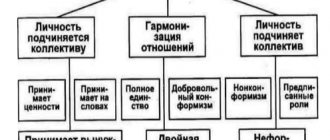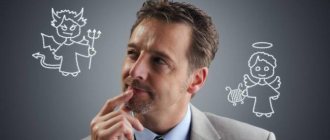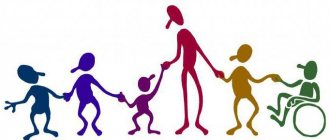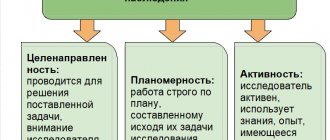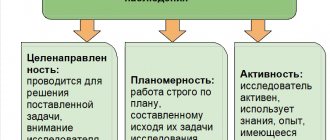About observation in general
Observation is the purposeful study and recording of the behavior of an object. The observer must create the conditions for the process, but they should in no way interfere with life.
Observation differs from passive contemplation of reality, since it has a specific goal, is carried out according to a pre-drawn plan and has special substantive means that allow not only recording the results, but also maintaining the situation at the required level.
We can say that observation is an active form of sensory cognition. With its help, you can accumulate empirical information, form initial ideas, or test pre-made assumptions regarding the object of study. It is believed that this method became the first scientific method of psychological research; during the development of science, several specific types of observation were formed.
The essence of the method
Observation in psychological science, unlike everyday observation, is based on a specific plan, a program thought out in advance, and requires recording facts, their analysis and interpretation.
Only external (speech, motor) manifestations are available for tracking. For example, it is impossible to observe:
- intelligence, but the researcher can monitor the process of solving problems;
- sociability, but you can see the fact of communication with other people.
Observed situations, phenomena, and behavior of objects are necessarily recorded in protocols and diaries. The observed characteristics are presented as descriptively as possible, without explanation. The form of the protocol reflects the subject, task, hypothesis and main criteria of the study.
The reliability of observation results increases if the researcher has the opportunity to use the method for a long time, to observe objects in different situations and roles. The reliability of the study also increases if several observers monitor the situation.
Qualitative observation is only possible if there are no role relationships between object and subject. For example, a schoolchild behaves differently in the presence of parents, teachers and friends. Therefore, the characteristics that different people give it differ.
Psychological observation does not allow the subject to intervene in the situation being studied. The observation results are necessarily supported by data from other research methods.
Three meanings
Typically, observation is viewed from three different angles. Depending on the situation and scope of use, there are:
- Observation as a method.
- Like an activity.
- Like a technique.
Observation can be a scientific method, then it will include a system of principles of knowledge, provisions on essence and the specifics of psychological observation about the possibilities of human activity. This option is considered universal and is used to study a wide range of phenomena. The observation method is quite flexible, and if the need arises, the researcher can change the “field of coverage”, put forward and test additional hypotheses during the experiment. In addition, such activities require minimal hardware. The specificity also lies in the attitude towards the object being studied: the researcher does not interfere in his life, but at the same time maintains visual and auditory contact.
Observation as an activity is used in some practical areas. For example, an energy systems operator monitors instrument readings, a doctor examines patients, an investigator monitors a criminal, etc.
On the third hand, there is also an observation technique. It is a socially fixed subject system for collecting and processing data, which is presented in a language understandable to others and corresponds to previously identified tasks.
Observation units, their registration
Units of observation are simple or complex actions of the object of study that are accessible to the observer. To register them, special documents are used:
1. Observation card. It is necessary to register certain characteristics in a formalized and often coded form. As the study progresses, several of these cards can be used, separately for each unit of study.
2. Observation protocol. Designed to record combined results in formalized and informal procedures. It reflects the interaction of observation cards.
3. Observation diary. Psychology often uses various observation logs. They are necessary in order to record the results of the study. They indicate not only various information about the object itself, but also the actions of the observer committed during the study.
When recording the results, various film and video equipment can also be used.
Features of the method
Various types of observation have been widely used since the end of the 19th century in those areas where the behavior of a person caught in various situations was of particular importance. Observation was and is used in cases where the researcher cannot or is not allowed to interfere with the natural course of the life process.
Observation is considered an indispensable source of information if a psychologist needs to create a holistic picture of what is happening and display the behavior of each participant in its entirety. The main features of the method include the following characteristics:
- Direct connection between the researcher and the object of observation.
- The emotional component of the experiment.
- It is difficult or impossible to conduct a similar experiment again.
In the natural sciences, the researcher usually does not influence the phenomenon being studied. On the other hand, in psychology there is a problem of interaction between the scientist and the subject. If a person knows that he is being monitored, this can significantly affect his behavior. Therefore, in order to minimize such an impact, the observer needs to “become familiar” to the subject or justify his presence with some reason that does not focus attention on the person.
Definition of the concept
In social, clinical and educational psychology, observation as a research method has been used since the end of the 19th century, and in the last century it began to be used in labor science. This is the most ancient method of understanding surrounding objects and phenomena. In everyday life, a person himself does not notice how he begins to observe someone or something.
Observation cannot be called a process in which the intervention of the experimenter changes the conditions of its implementation. But it will help in cases where it is necessary to obtain a holistic picture of ongoing events and reflect it in records and tables. Main features of the procedure:
- connection between observer and subject;
- partiality - emotional component;
- difficulty and sometimes impossibility of repeating.
If the observation is carried out in natural conditions, then the person will not influence it in any way. But when the subject knows that he is being examined, he changes his habits.
The first experimenters were V. Prier, V. Stern and A. Gvozdikov. They observed the development of the child in the family and recorded the information received in their diaries.
Types of surveillance
Typically, the type of observation is determined by the goals, object and situation of the study. Thus, it is customary to distinguish:
- Objective observation and self-observation.
- Field and laboratory research.
- Individual and collective experiment.
- Random and intentional learning.
- Systematic and non-systematic observation.
- Complete and incomplete research.
- Complete and selective experiment.
- Ascertaining and evaluative learning.
- Standardized and non-standardized observation.
- Open and closed research.
- Included and unincluded experiment.
- Direct and indirect research.
Thus, we see that there are 12 pairs of forms, types and methods of observation. Let's look at them separately.
Accepted classification
Observation is usually used when it is impermissible or simply impossible to interfere with the natural course of an event. It is divided into several types:
- external and internal;
- direct and indirect;
- direct and indirect;
- included and not included;
- field and laboratory;
- continuous and selective.
There are also different types of observation depending on the systematicity, form, objects recorded, and awareness. In the first case, there are non-systematic and systematic studies. The latter are carried out according to a specific plan, and during the experiment a person records the characteristics of the subject’s behavior and creates a classification of environmental conditions. Non-systematic ones allow you to create a general picture of a phenomenon under certain conditions. Typically such studies are field studies.
Observation is contrasted with experiments according to two criteria: spontaneity and passivity of the researcher. He cannot interfere in the course of the process, but he must write down what he sees in the protocol.
Based on the recorded objects, continuous and selective observations are divided. With the first, a person tries to note down all the features of behavior. And with the second, it records only certain acts or parameters. Depending on the forms of behavior, several studies are distinguished: conscious, unconscious external and internal, the surrounding world.
With awareness, the subject knows that he is being observed. That is, the researcher contacts him, tells him in advance about the task of the experiment and his social status. But sometimes he is given incorrect information in order to monitor his behavior in a certain situation. Although such actions lead to ethical problems and negative results.
This method is used only if it is due to observation requirements. It is necessary to conduct several studies, since the actions of the subject depend on the influence of the scientist, and if the task is incorrectly stated, the results will not meet expectations. The observation situation can be stressful for the subject, and the results will negatively affect his life.
Unconscious inner
Unconscious internal observation is different, because with it the subject does not know anything about the study. The one who conducts the assessment becomes part of the system. For example, a psychologist can infiltrate a group of representatives of a subculture to study behavior in detail. The observer is in close contact with the subjects, but they have no idea of his purpose.
This method is used to study the social characteristics of small groups. The observer must behave naturally, then his work will not influence their actions and the conclusions of the protocol. But ethical issues can become a problem: the researcher will have to deceive the group. He will also have difficulties with recordings - the results must be recorded secretly so that no one notices.
The fact that surveillance is being conducted will not affect the subject's behavior in any way. And with direct contact, the researcher will receive more information. But this can also cause some problems: sometimes psychologists adopt the value system of the group being studied, and moral conflicts arise.
External type
The definition of external unconscious observation is that the subject is unaware of the experiment. The researcher does not have contact with the group; he records information from the outside. For example, in psychiatric hospitals, the doctor monitors the patient through a special window. From the doctor's perspective, it is transparent, but the patient sees it like a mirror.
This organization of observation makes it possible not to embarrass subjects or provoke them to certain actions. Thanks to this, the researcher can collect objective information about the behavior or phenomenon. Another plus is that if at any stage the observer gets tired, he will be quietly replaced by another.
The naturalness of actions is not disrupted due to the pressure of the researcher; it becomes possible to use technical means of recording information. But due to limitations, it will be necessary to study the situation only from one side; it will not be possible to learn in more detail about the behavior of the subjects.
By observing the environment, we can learn more about the conditions that influence people's actions. Modeling certain situations will help to study all the factors influencing the subjects being studied.
Objective, laboratory and field research
The first type of observation method that you should pay attention to is called objective. This is the study of an object from the outside, that is, the observer looks at those objects that are external to him. This type of observation is widely used in psychology and sociology, as well as in related disciplines. This method is also called external observation.
Introspection (self-observation or internal exploration) was used in the early stages of the development of psychology. The subject independently observed himself and recorded changes in consciousness. Nowadays this method is used very rarely.
Field observation (also known as natural observation) involves the study of objects that are in their natural habitat. This type of observational method is generally considered a stand-alone method of data collection. It can be combined with other research methods if observation is the main component of the study, and all other methods are auxiliary or will take place at a different time.
Experimental or laboratory research is carried out in artificially created conditions. The degree of this artificiality can be different: minimal (when a casual conversation is being conducted) or maximum (when a person is placed in a special room and given instructions for behavior). Unlike field research, experimental observation is almost always associated with other empirical research methods.
Advantages and disadvantages
Any type of observation method in psychology has advantages and disadvantages. The advantages include the ability to capture and record acts of behavior of interest and include them in the reporting protocol. The psychologist simultaneously examines the relationships of subjects with each other and with other objects and phenomena. In some cases, even their consent or preparation will not be needed.
You can record several parameters at once - movements and physical interaction, verbal and non-verbal communication . Psychologists receive information quickly, and the method itself is quite cheap. If you do not use special recording equipment, then no costs will be required.
But observation also has its downsides. There are too many distractions and factors that interfere with research. Circumstances rarely repeat themselves, so if one phenomenon is missed, it will not be possible to draw a correct generalizing conclusion. All results must be classified according to specific parameters. Different types of surveillance will require a lot of time and effort.
Psychological research methods make it possible not to assume, but to accurately find out some information from the life of subjects. With the help of observation, one can understand the essence of an individual’s behavior, his attitude towards others and himself.
Individual, collective, accidental and intentional observation
Individual research is a type of statistical observation that is carried out by one scientist. The observer may be the only one studying the project, but may also be part of a team of scientists. In the latter case, he will study the object independently, but his work will be part of the project.
Collective research is carried out by a group of several individuals. They have a common plan of action, use the same methodology and pursue the same goal. In some cases, it is assumed that this type of observation in psychology is determined by the simultaneity of the research.
A random study is not planned in advance, but is carried out because circumstances arise. This type and method of observation is valuable in the study of rare phenomena, the occurrence of which cannot be predicted. For example, here we can talk about UFOs or sudden natural disasters. Random observations are divided into two types: everyday and professional. Every person makes everyday observations in everyday life. Professional incidental observation occurs unintentionally as a result of professional activity. In this case, the scientist is already internally ready to conduct observations and can see something interesting where an ordinary person cannot. This is how many discoveries of the past were made. Deliberate surveillance is planned and serves specific purposes.
Distinctive Features of Observation
Observation in psychology is always carried out for a specific purpose, according to a predetermined plan, and is equipped with various objects necessary to record the results and carry out the process itself.
This method allows you to collect empirical data, form ideas about the objects of research, and also test various guesses and theories associated with it.
Observation carries out cognition through direct contact, based on the readings of the senses, therefore it is the first scientific technique in history.
Methods of psychology (observation, experiment, etc.) have their own characteristic features. These features make it possible to distinguish them as a separate type of research. Observation in psychology is distinguished by the type of relationship to the object (for example, in a conversation or experiment, a specialist creates special conditions that cause this or that phenomenon), the presence of direct contact with it (which is absent when studying the products of activity, and is also not always present in the experiment).
From a methodological point of view, it is characterized by universality, that is, the ability to use observation in relation to a wide range of different mental phenomena, as well as flexibility (the ability to change the “field of coverage” of an object or hypothesis during the research process) and minimal requirements for the technical and hardware support of the procedure. In this, the methods of psychology, observation, experiment and others, are very different.
In the scientific literature, the terms "observation", "objective observation" and "external use" are often used interchangeably. Mental life is a complex phenomenon, inaccessible to direct view from the outside, hidden from prying eyes. Therefore, initially the only method of psychology was introspection (self-observation), and only with the development of science did external observation begin to be used when observing a person (psychology, sociology and other sciences).
In Russian psychology, the basic principles of observation are described in the works of such scientists as S. L. Rubinstein, L. S. Vygotsky, A. N. Leontiev.
Systematic and complete studies
Depending on the systematicity, types of observation are divided into systematic and non-systematic.
Systematic observations are carried out according to a pre-created plan and schedule. The concept of systematicity is considered here in two aspects:
- Procedural. There are clearly defined tasks and goals, and a working hypothesis is formulated. The observer's actions are determined and ordered in advance. You can also observe a well-thought-out system of recorded indicators.
- Temporary. Multiple observations are planned and balanced in advance. Simply put, a person is observed, some manifestations of character are recorded, and this procedure is repeated when his life situation changes or he reaches a certain number of years. For example, through time observation it was found that a person's character changes every seven years.
On the other hand, there are non-systematic studies that do not have a specific plan of action. The procedural aspect is manifested in the uncertainty of tasks and there is no provision for recording facts. The time aspect is expressed in conducting multiple observations randomly.
Another type of statistical observation is called complete. The main task of the researcher is to cover and record all available information about the subject of study. Typically, this method is used to better study the object of study. However, there are situations when such an approach is a necessary measure. This happens in cases where it is unknown what factors influenced a person’s behavior.
With incomplete observation, the researcher pays attention to the optimal number of factors on which certain conclusions can be drawn. Before starting an observation, the researcher makes a list of factors that need to be paid attention to, usually in order to eliminate unwanted information gaps.
Observation as a method of psychodiagnostics
Observation is a purposeful, organized and recorded perception of the object being studied in a certain way.
Features of the observation method:
- direct connection between the researcher and the object of observation; simultaneity of the event and its observation;
- data about the object of observation was obtained from the observer;
- holistic perception of the observed situation;
- dependence of data on the state and settings of the observer;
- the influence of the observer on the object of observation;
- the influence of the object of observation on the observer’s perception of its signs and their assessment.
Scientific observation involves direct, immediate perception of events or participation in them.
It has much in common with everyday observation of how a person perceives what is happening in everyday life, analyzes and explains people’s behavior, connects it with the characteristics of operating conditions, remembers and generalizes the events that he witnesses.
Differences between scientific observation and everyday observation:
- goals and objectives, object and subject of observation are clearly formulated;
- carried out according to a pre-planned plan;
- observation data are recorded in protocols according to a specific system;
- the information received is subject to control for validity and stability.
Observation has its own characteristics, advantages and disadvantages that must be taken into account when using it.
Advantages of the observation method:
- direct perception of the behavior of the observed object in real time;
- efficiency of obtaining information;
- objectivity, specificity of data;
- unity of the emotional and rational in the perception of the situation;
- expanding the capabilities of intuition in understanding and explaining phenomena;
- the ability to more accurately understand the meaning of people’s behavior through identification with the values and goals of the objects of observation.
- the ability to use the observer’s experience in identifying problem situations, flexibility of research settings;
- the possibility of bringing the object closer to the conditions of the experimental situation.
Disadvantages of the observation method:
- locality of observed phenomena, limited nature of the observed situation;
- impossibility of repeating the events of the situation;
- difficulty in differentiating and identifying signs of the observed situation;
- distortion of the natural state of an object limits the possibilities for generalization;
- the passivity of the method, its dependence on the states of the object existing at the time of observation.
- the possibilities of obtaining data on goals and motives of behavior are limited;
- subjectivity, distortion, errors in the registration of signs due to emotions, low qualifications, incorrect attitudes of the observer.
Typical observation errors:
- Halo effect - the generalized impression of the observer leads to a rough perception of behavior, ignoring subtle differences.
- The leniency effect is the tendency to always give a positive assessment of what is happening.
- Error of central tendency - the observer tends to average the observed behavior.
- Correlation error - an assessment of one behavioral characteristic is given on the basis of another observed characteristic (intelligence is assessed by verbal fluency).
- Contrast error is the tendency of the observer to identify features in the observed that are opposite to their own.
- First impression error - the first impression of an individual determines the perception and assessment of his further behavior.
Observation is indispensable in cases where:
- it is necessary to explore natural behavior without outside interference in the situation,
- you need to get a holistic picture of what is happening and reflect the behavior of individuals in its entirety.
Classification of types of observation
Types of surveillance
All types of observation can be combined in different ways. Let's consider their individual types.
Supervised observation
- provides in advance for observation situations and specific ways to record facts,
- used in descriptive and experimental studies, when the researcher is familiar with the phenomenon being studied.
Uncontrolled surveillance
- used in intelligence research for the purpose of preliminary acquaintance with the problem,
- When conducting, there is no detailed action plan for the observer; only the most general features of the situation are defined.
It is used in practice at the initial stage of research, as well as in conjunction with other methods of data collection, supplementing and monitoring the information obtained.
Open surveillance:
- involves notifying the observed about the observation being carried out,
- carried out with the aim of studying the psychological compatibility of the group, crew, as well as identifying individuals prone to deviant behavior.
Covert observation - carried out by an incognito observer, when the observed do not know that they are the object of research,
Participant observation - the observer himself is a member of the group whose behavior he is studying:
- involves the direct participation of the observer in the events taking place,
- the researcher may not stand out as an observer (hidden participant observation), studying this population as if from the inside.
Participant observation is not always used as covert observation. Options for included open observation are also possible.
Participant observation options:
- the observed people know that their behavior is being recorded by the researcher (when studying the dynamics of behavior in a group of climbers or a submarine crew - the film “ 72 Meters ”).
- those being observed do not know that their behavior is being recorded (children playing in a room where one wall is a Gesellian mirror; focus groups). This allows us to record hidden social phenomena in teams.
Non-participant observation:
- carried out from the outside
- the observer is not a participant in the events taking place.
Non-participant observation can be either hidden or open.
Field observation:
- the most common type of research,
- occurs under natural conditions observed;
- really reflects various aspects of the life and activities of the object.
During field surveys, observations should be distinguished:
- indifferent,
- passive,
- actively participating.
An example of indifferent observation would be observing the behavior of fans at a stadium during a football match. Naturally, none of them suspects that they are being “examined,” therefore, the procedure does not in any way affect the normal self-expression of the observed people.
It is not so easy to guess that active participant observation is being conducted, especially if the researcher behaves at ease and gives the impression of simply an inquisitive “stranger.”
In active participant observation, the researcher lives with the group or community he is studying, participating directly in their activities.
Laboratory observation:
- characterized by artificial conditions that only simulate natural,
- the researcher himself determines these conditions, place and time of observation.
The advantage of laboratory observation is an in-depth study of individual aspects of an individual’s activity.
During laboratory observation, various technical means are widely used - photography - film - video - equipment, measuring instruments.
Systematic observation:
- carried out regularly with a specified frequency,
- carried out according to a fairly structured methodology with a high degree of specification of all activities of the observer, according to a specific plan,
- the recorded behavioral features (variables) are highlighted,
- classifies environmental conditions.
Non-systematic (random) observation:
- usually not planned, is a rich source of information,
- the difficulty of this type of observation lies in the unpredictability, randomness of the occurrence of events,
- productively for a more or less long period of time.
It is carried out during field research and is widely used in ethnopsychology, developmental psychology, and social psychology.
What is important is not the fixation of causal dependencies and a strict description of the phenomenon, but the creation of some generalized picture of the behavior of an individual or group under certain conditions.
Episodic observation is the recording of the phenomena and events being studied in the absence of clear regulations for recording them in certain time intervals or at various stages of their occurrence.
One-time observation – one phenomenon or event is recorded that occurs in a certain place and at a certain time, for example, non-participant observation of students’ behavior in class carried out by a psychologist.
Panel observation is a process of repeated, extended over time, carried out at certain intervals, systematic and organized observation of the same object in order to identify its changes.
Non-standardized observation is the study of psychological phenomena and processes when only the object of observation is determined, but the elements of the process being studied and the events that will be observed are not determined.
Most often used at the initial stage of psychological research in order to identify a problem situation.
Standardized observation is a method of collecting empirical psychological information, when not only the object and subject of research, but also the composition of the elements of the process being studied are predetermined.
Standardized observation can be used as the main method of collecting information to accurately describe the subject of research and as a way to verify, clarify, and correct results obtained by other methods.
“Continuous” observation - the researcher (or group of researchers) records all behavioral features available for the most detailed observation,
Selective observation - the researcher pays attention only to certain parameters of behavior or types of behavioral acts.
Observation can be:
- direct;
- using observation instruments and means of recording results (audio, photo and video equipment, special observation cards, etc.).
The best way to study behavioral manifestations is continuous observation .
The best method of recording is a hidden audiovisual recording , which could be analyzed repeatedly. For psychological diagnostics, all behavioral manifestations of the patient (both verbal and non-verbal) that have diagnostic significance are of interest.
During observation, something can be recorded that cannot be recorded by any other method, namely:
- behavior style,
- gestures,
- facial expressions
- movements of individuals and entire groups.
Observation is used in conjunction with other methods of collecting information, enriching dispassionate statistics with living material of perception.
The observation method is one of the most complex and time-consuming research methods, which involves drawing up an observation program .
The program prescribes the stages of the observational research procedure:
1) a problematic situation is identified,
2) goals and objectives are determined,
3) the object of observation (individuals or a group), the subject of observation (the behavior of an individual or group), and observation situations are determined;
4) the method of observing and recording data is selected;
5) an observation plan is constructed (situations - object - time);
6) a method for processing the results is selected;
7) observation is carried out according to the plan;
 processing and interpretation of the received information is carried out.
processing and interpretation of the received information is carried out.
To register various actions of the observation object (observation units), the following documents are used:
a) observation card - designed to record signs of observation in a strictly formalized and, as a rule, coded form;
b) observation protocol – intended for combined registration of observation results in formalized and informal procedures. Reflects the algorithm for the interaction of various observation cards;
c) observer’s diary – designed to record the results of observation. It notes not only information about the object, but also the actions of the researcher during the observation, and evaluates the tools.
moment observation method
Sample experiment and statement of facts
Continuous observation is permanent and is used for short-term study of an object in order to obtain more complete information about the dynamics.
The form and type of continuous observation is often confused with complete observation. However, the “complete - selective” scale characterizes temporary reality, and the “complete - incomplete” scale characterizes quantitative reality. That is, any continuous observation can be either complete or incomplete. Sample observations are usually carried out in separate time periods. The researcher determines at his own discretion.
Another type and method of statistical observation is ascertaining. Any phenomena are recorded by the researcher, but are not discussed or evaluated. As a rule, recorded facts do not require additional interpretation. For example, photographs - it is difficult to interpret the image in any other way.
Evaluative observation is a type of activity in which the researcher evaluates a situation or a fixed phenomenon. Typically, this method is used when hypotheses are made and the factors that unite the perceptual process need to be explained. Evaluative observations are generalizing and interpretive.
Full and incomplete observation
Complete - observation in which the maximum information available to the observer is recorded and recorded. Used for extremely thorough examination of an object. Often, complete observation is carried out as a coercive measure, when it is not known in advance which factors of the situation and behavior of the observed should be recorded and which are not necessary, which are considered significant and which are not important, which can be expected and which are not predictable. This situation usually accompanies a preliminary, indicative study that precedes the main cycle of research, in which the observation will already be more focused and specific, with a limited field of search. Sometimes the researcher has to resort to full observation due to poor preparation and forethought in the preliminary stages of the study - problem statement, hypothesis formulation and planning.
It is clear that the completeness of information is a relative matter, and its degree depends on the objective and subjective abilities of the observer, as well as on his understanding of “absolute” completeness. Thus, the “exhaustive” completeness of observation characterizes the methodological crudeness of a particular study rather than its “empirical richness” and the breadth of interests of the researcher.
Incomplete is an observation in which the observer’s attention is focused on the optimal (less often, minimum) number of parameters of the situation and behavior of the observed. This range of information that needs to be collected is determined in advance, based on the purposes and conditions of observation. As a rule, such regulation of the observation process does not strictly limit the actions of the observer, but only prevents unwanted gaps in the information sought.
In other words, it does not prevent the observer from going beyond the established set of questions if this turns out to be necessary or useful for the process, but only directs him to an infinite variety of monitoring situations. Thus, this limitation not only does not “tie the hands” of the observer, but, on the contrary, frees him from the previous problems of choosing what to observe and what to record. And this allows for more careful and attentive observation of the main thing (according to the research hypothesis) and increases the likelihood of discovering additional important (in the observer’s opinion) facts. This increases the reliability and accuracy of observational data. Obviously, partial surveillance is much cheaper and usually more effective than complete surveillance. This type of observation is typical for baseline and control studies.
Continuous - continuous observation of an object without interruption. It is usually used for short-term research or when it is necessary to obtain the most complete information about the dynamics of the phenomena being studied.
Sometimes continuous observation is interpreted as complete. It does not seem reasonable to mix these characteristics; it is better to adhere to a more traditional view: the “continuous - sample” parameter reflects the “temporal strategy” of the study, and the “complete - incomplete” parameter reflects the quantitative one. […] From this observation it follows that any continuous observation can be either complete or incomplete, and it is even more rational to conduct continuous observation after an incomplete one. The reverse is also true: any complete or incomplete observation can be either continuous or selective.
Sampling is observation made at discrete time intervals chosen at the discretion of the researcher. It is less expensive than continuous monitoring. This is advisable for long-term, protracted research, as well as for filling scattered gaps in knowledge about a known holistic phenomenon. Naturally, the authors consider continuous observation to be complete; selective observation is equated to incomplete. Continuous observation is observation in which the observed phenomena and activities are simply recorded and are not subject to discussion or evaluation by the researcher during the observation.
Standards. Open and closed research
Also, observations can be standardized or non-standardized. The first are carried out according to a pre-agreed scheme, which is a reference for fixing and recording parameters in a specific situation. For example, if the phenomenon being studied is clear and you only need to record some elements, researchers can use forms that are made according to a certain standard. In turn, non-standardized observation is carried out in a free form. As the researcher wants, he describes what is happening. This method makes it possible to look at an object from a different angle and allows you to see patterns that were not previously noticed.
In open observation, individuals are aware of their role as “test subjects,” and at times even know the observer. True, this method somewhat limits the field of action of the researcher. Covert research is carried out unbeknownst to the subjects and is considered more common, although it can often entail ethical difficulties.
Methodology
This term usually means a regulated, set out for a special circle of people, a substantively designated system of methods for selecting and analyzing the information obtained, which corresponds to a specific range of tasks.
Such techniques are classified according to methods of organizing observation, methods of dividing the observed flow of reality into components, the properties and significance of units of research, methods of recording it, and methods of analyzing the results.
The methodology, as the most complete description of all research steps, includes:
- The choice of circumstances and object of observation, which is determined primarily by the purpose of the study and theoretical ideas about the reality being studied.
- A schema in the form of a variable list of observation units and aspects of their behavior.
- The method and form of recording the observation results, a description of the requirements for organizing the work of the observer, a description of the method of processing and presenting the obtained data.
Involved, direct, provoked
In participant observation, the researcher is part of the group being studied. So to speak, trying to understand it from the inside. Despite its many merits, this observation has a significant drawback: scientists may lose objectivity by moving from the position of scientist to the role of test subject.
It is worth noting that observations can be carried out not only by people interested in the results, but also by their representatives. When a scientist observes, it is a direct study; when an intermediary, it is an indirect study. Typically, indirect observations refer to obtaining information from witnesses to an event. For example, in law enforcement agencies, the testimony of people who have become unwitting witnesses to a crime is important.
Example of observation situations
The observation method in psychology is implemented using examples of typical situations, among which it is worth noting:
— Training sessions. During such activities, the general level of training, skills, knowledge, the degree of diligence of the soldiers is determined, the level of cohesion of the team as a whole, and the degree of its desire to acquire knowledge are revealed.
- Breaks, leisure hours. In these situations, the observer may be interested in the topics of conversation, the leaders and their influence on other participants in the dialogues, and the different opinions and points of view of the soldiers.
- Household work. Of interest here may be the attitude towards the work of those being studied, the various relationships between military personnel when performing household work, as well as leaders and subordinates. It is important to note that in the presence of large volumes of work, as well as in critical situations (earthquake, fire, flood), qualities such as endurance, determination, cohesion, and mutual assistance of team members are especially evident.
— Changing of the guard, divorce and service. In these situations, the degree of military training, the level of skills and abilities, motivation to perform duties, and the beliefs of the soldiers are revealed.
- Evening verification. Here you can pay attention to general discipline, the reaction of the military to official duties and their distribution.
A special role is played by various conflict situations, in which the relationships between soldiers and their behavior are most clearly manifested. It is important to note the instigators, as well as indicate the causes, dynamics and outcome of the conflict, and determine the roles of the various participants.
Subject of observation
Depending on the subject of study, the researcher selects the necessary forms and types of statistical observations. Typically the objects are:
- Verbal behavior - the content, duration and intensity of speech are also taken into account.
- Nonverbal behavior - facial expressions and gestures are examined.
- Movement of people.
Simply put, objects can be any situation that can be clearly captured. The researcher is not interested in the properties of the psyche, only statistics and facts. But based on the position that the properties of the psyche are manifested in behavior, a psychologist, based on the collected facts, can build hypotheses on mental properties.
Rules for conducting observations
When conducting research, it is important to fulfill the following requirements:
- Decide in advance which type of observation will be more optimal, and draw up a research program, highlighting the most important objects and stages.
- Do not influence the natural course of events in any way.
- Observation must be repeated and systematic (especially if it concerns the study of personality).
- When studying psychic phenomena, observations must be made on different objects. Even if you need to study a person, more detailed information can be obtained by comparing him with others.
Observation Example
The observation method in psychology is well illustrated by examples. Let's look at a specific example where this technique is used.
For example, a military researcher needs to find out which military personnel are prone to various offenses, for example, money-grubbing, drunkenness, and violence. The objects of observation are newly arrived soldiers.
First, the researcher collects information about them through the officers of the units to which the research objects belong. This information can be obtained, for example, from those who accompanied new arrivals to the place of service from the recruiting station, through conversation, and analysis of documents. In this case, it is necessary to especially pay attention to the social environment in which the soldier grew up and was brought up (prosperous or dysfunctional, complete or single-parent family, belonging or not belonging to a group with negative value orientations), to his behavior (whether or not he was brought to criminal or administrative responsibility , the presence or absence of negative characteristics from work or study), on his psychological and physiological characteristics (character traits, level of development, etc.).
Next, the researcher notes potentially troubled soldiers by analyzing the information received.
At the same time, the observer determines special signs that make it possible to judge the tendency of objects to deviate behavior. It is believed that persons with deviant behavior include soldiers whose behavior does not correspond to the moral and legal norms accepted in this society. This could be, for example, a dishonest attitude towards official duties, disobedience to commanders, insulting colleagues, stubbornness, attempts to dominate, etc.
Based on these signs, researchers collect detailed information about all soldiers through mostly random observation, and then draw up a detailed research program.
The student identifies situations, categories and units of observation, prepares tools (protocols, cards, observation diaries).
Surveillance Tools and Code of Ethics
Observation can be carried out by the researcher himself, or he can use various recording devices - voice recorders, cameras, etc. It is important to understand that observation is not an experiment, because: firstly, it does not change the surrounding reality, and secondly, the observer It records only what it sees.
In Russia, scientists can carry out observations at any time convenient for them. In America, things are not so simple. There is a code of ethics of the American Psychological Association, which allows observation, subject to certain rules, namely:
- It is necessary to obtain the consent of the participants to conduct the study. The only exceptions are observations that are carried out in public places.
- Psychologists should not cause harm to subjects, and if it cannot be avoided, reduce possible harm.
- Minimize invasion of privacy.
- Do not disclose confidential information about observation participants.
In psychology, observation is considered an indispensable source of empirical information, because only when alone or in familiar conditions does a person shed all masks, allowing emotions to take precedence over reason, thereby exposing his true essence.
Types of objects
Observation and experiment in psychology, as well as other methods, can have the following objects of study:
- person (or animal);
- a whole group of people.
The subject of observation can, as a rule, only be the external component of activity (movements, movements, contacts, joint actions, speech acts, facial expressions, external manifestations of vegetative reactions, as well as various situations, both spontaneous and organized).

